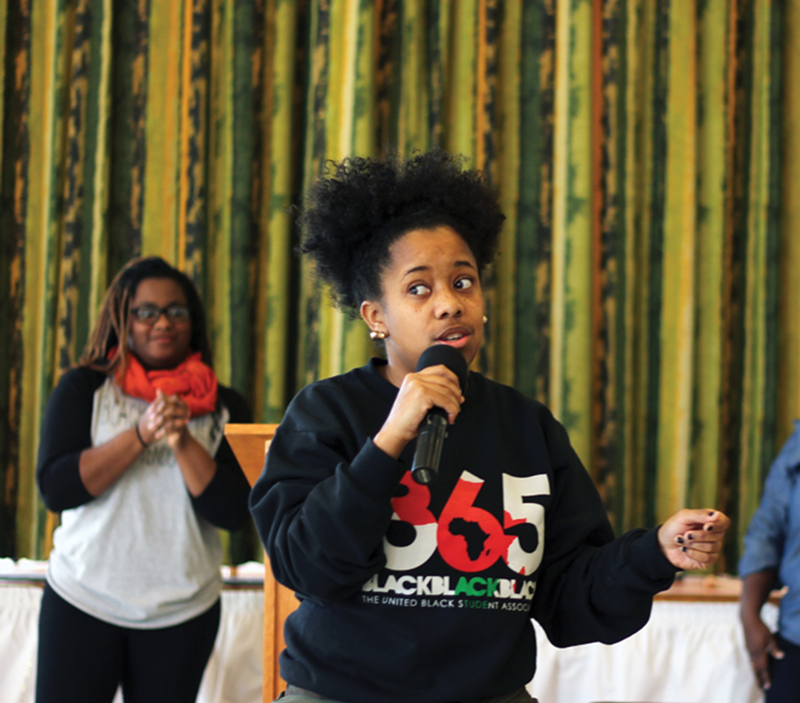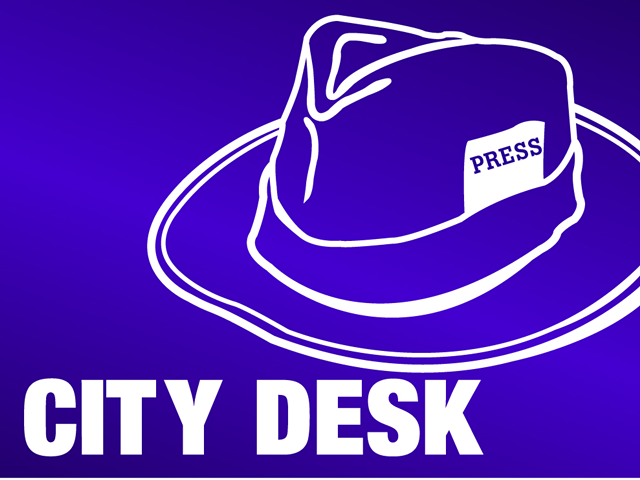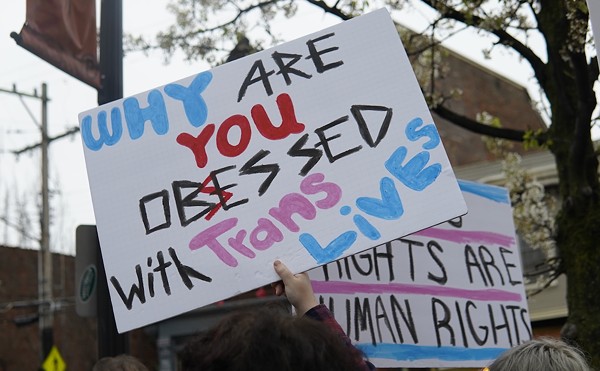M
ore than 70 people sat in the chilly auditorium at Truth and Destiny Covenant Church in Mount Airy Jan. 24 listening raptly to two attorneys talk about traffic stops.
The presentation on legal rights was part of a three-hour teach-in and community discussion put on by a group of local activists who have recently taken to calling themselves Black Lives Matter Cincinnati. The event, promoted mostly on social media, followed a similar two-hour session last month that drew more than 100 to the Peaslee Neighborhood Center in Over-the-Rhine.
The teach-ins, along with other forms of organizing by a loose collective of activists, represent a widening of focus for those continuing to ask questions about the deaths of unarmed black citizens at the hands of police officers, including the shooting deaths of 22-year-old John Crawford III last August in Beavercreek and 12-year-old Tamir Rice in Cleveland last October.
Activists have begun looking to more deliberative ways to draw attention to issues around racial disparities in the justice system beyond the November and December rallies that drew hundreds downtown. Those events took place after a Missouri grand jury announced it would not indict Ferguson, Mo. police officer Darren Wilson in the shooting death of unarmed 18-year-old Mike Brown.
Cincinnati’s activists are using questions and conversations as much as the exclamation points and pithy slogans of rally posters. Among them is Christina Brown, who attended the first rally downtown in November organized by the Greater Cincinnati chapter of the National Action Network. Brown subsequently organized a Dec. 13 rally on Fountain Square herself. It drew more than 100 people. Shortly after, Brown and a group of fellow activists coalesced into Black Lives Matter Cincinnati.
The group isn’t directly connected to national groups. They say their approach is meant to be local, collaborative and searching.
“We don’t want to be the experts,” says organizer Rashida Manuel. “We just want to organize the energy that’s already there, kind of facilitate that energy. This is not a movement of eight people. This is a movement of all these people in Cincinnati.”
While the group has been around for just over a month, it has already organized two teach-ins and a candlelight vigil for those who have died at the hands of police. The group has also stepped into the fray of a high-profile debate swirling around Norwood Mayor Thomas Williams. Last month, Williams posted a letter of support for the Norwood Police Department on social media. In that letter, Williams blasted what he calls “race-baiting black leaders and cowardly elected officials” who continue to question police use of force after events in Ferguson, Beavercreek, Cleveland and elsewhere around the country.
The letter is a local iteration of the continued tension between police forces and some public officials and members of the black community over the issue of racial disparities in America’s justice system.
The most high-profile iteration of this ongoing friction has been in New York City, where continued protests have erupted over the July death of an unarmed black man named Eric Garner shortly after New York City Police officer Daniel Pantaleo put him in a choke hold. Police officials criticized the protesters and those, including Mayor Bill DeBlasio, who appeared sympathetic to them. The gulf only widened when a man who may have been suffering from a mental illness gunned down two officers in Brooklyn in December.
Months after a series of grand juries refused to indict police officers involved in the high-profile and racially charged incidents around the country, tensions are still high. That’s especially true in Cincinnati, where civil unrest broke out in 2001 after Timothy Thomas was shot and killed by officer Stephen Roach. Thomas had been the 15th black citizen killed by police over the course of a few years.
Williams’ letter, which appeared to express unconditional support for police, hss kept the issue front and center.
“As soon as that hit our radar, we said, ‘We have to reply,’ ” Brown says. “It’s still astounding that in 2015, in this time, that you’d put that on the Internet.”
The group put out its own letter in response to Williams asking for an apology and pointing out Norwood Police Department’s history with what they say are racially charged incidents.
In 2013, an officer with the force resigned after pleading no contest to misdemeanor assault against a suspect. And last year, the department was hit with a federal civil rights lawsuit from Maurice Snow, a black man wrongfully imprisoned for 52 days by Norwood Police. Snow was detained on cocaine charges after an investigation by the department. However, he was freed after video footage the police possessed the whole time revealed they had arrested the wrong person.
Norwood Police Chief William Kremer has tried to further explain Williams’ statements, saying they don’t mean the mayor would blindly support the police if they were doing something illegal. Williams hasn’t replied to the group’s letter. The group said it would appear at the next Norwood City Council meeting Jan. 27 in protest.
At the most recent teach-in, attendees wrestled with the situation in Norwood and the wider issues around race and the justice system. Some attendees wondered if the system as it is currently established could ever really be fair to people of color; others had mixed feelings.
Iris Roley, a longtime advocate for police reform who helped shape Cincinnati’s collaborative agreement between the community and Cincinnati Police Department in the wake of Thomas’ death, touted the agreement and stressed the importance of continued efforts to both enter into a dialogue with law enforcement and to hold the larger justice system, including prosecutors and courts, accountable.
Other attendees admitted to experiencing a kind of cognitive dissonance about the justice system.
“I actually have a father who is retired from law enforcement,” said Kelly Crawford (no relation to John Crawford III), a baker who lives in Cincinnati. “So I have both perspectives and a respect for law. He’s one of the good guys. But I see these killings and the deaths of our children.”
As the workshops and group discussions continued into their second hour, a man in a long overcoat and a tie stood at the back of the room. It was John Crawford Jr., the father of John Crawford III, the young man killed by police in the Beavercreek Walmart. He was in town and saw his son’s face on a flyer, he said, and came to say thank you to those who organized and attended the event.
Crawford Jr. has his own mixed feelings about the justice system. He has worked in criminal justice much of his life, he says, but still can’t wrap his mind around what happened to his son. A grand jury declined to indict Beavercreek Police officer Sean Williams for the shooting, which was captured on Walmart security cameras.
“There’s a great deal of irony to have your child murdered by the same system in which you’ve carried your daily duties out,” Crawford said. “I’m still numb from the video tape. When you have that evidence from start to finish, and you still get no indictment … when you don’t have that, I’m saying to myself, ‘What’s really going on?’ ”
The question hung in the air, and each person sitting in a folding chair in the church auditorium seemed to have his or her own slightly different interpretation. But that’s the point, organizer Brown says.
“All these voices have equal contributions, are equally valid, and we all have answers,” Brown told the crowd before it dispersed. “The hard part is whether we stick together in our disagreements.” ©






